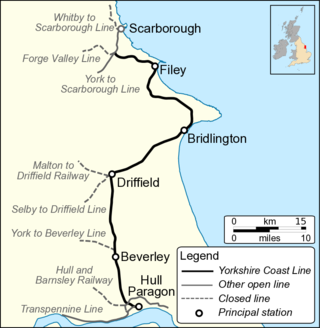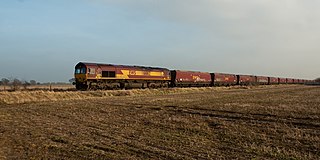
The East Coast Main Line (ECML) is a 393-mile long (632 km) electrified railway between its southern terminus at London King's Cross station and Edinburgh Waverley via Peterborough, Doncaster, York, Darlington, Durham and Newcastle. The line is a key transport artery on the eastern side of Great Britain running broadly parallel to the A1 road. The main line acts as a 'spine' for several diverging branches, serving destinations such as Cambridge, Leeds, Hull, Sunderland and Lincoln, all with direct services to London. In addition, a few ECML services extend beyond Edinburgh to serve Glasgow Central, although the principal London-Glasgow route is the West Coast Main Line (WCML).

The Dearne Valley line is the name given to a railway line in the north of England running from York to Sheffield via Pontefract Baghill and Moorthorpe. The route was built over several years and consists of lines built by several railway companies.

The Sheffield–Lincoln line is a railway line in England. It runs from Sheffield to Lincoln via Worksop, Retford and Gainsborough Lea Road. The route comprises the main line of the former Manchester, Sheffield and Lincolnshire Railway (MS&LR), to Gainsborough Trent Junction, where it then follows the former Great Northern and Great Eastern Joint Railway (GNGEJR) to Lincoln Central. The former MS&LR main line continues from Trent Junction to Wrawby Junction, Barnetby, much of it now single line, where it then runs to Cleethorpes. In 2023, the Department for Transport announced that a new station will be opened on the line. Waverley station will be located between Darnall and Woodhouse.

Selby railway station is a Grade II listed station which serves the market town of Selby in North Yorkshire, England. The original terminus station was opened in 1834 for the Leeds and Selby Railway. The Hull and Selby Railway extended the line in 1840 and a new station was built, with the old station becoming a goods shed. The station was rebuilt in 1873 and 1891; the 1891 rebuilding was required due to the replacement of the swing bridge over the River Ouse at the same time.

The Hull–Scarborough line, also known as the Yorkshire Coast Line, is a railway line in Yorkshire, England that is used primarily for passenger traffic. It runs northwards from Hull Paragon via Beverley and Driffield to Bridlington, joining the York–Scarborough line at a junction near Seamer before terminating at Scarborough railway station.

The Askern branch line is a railway line which runs in North, South and West Yorkshire in England. The stretch of track runs from Shaftholme Junction north of Doncaster, via Askern, Norton and Womersley to Knottingley, where it joins the Pontefract Line.

Doncaster PSB is a signalling centre on the East Coast Main Line (ECML) railway in the United Kingdom, principally covering the line from London to Edinburgh but also encompassing other lines diverging and converging to the ECML. The signal box celebrated its 25th birthday in 2006.
The Leeds and Selby Railway was an early British railway company and first mainline railway within Yorkshire. It was opened in 1834.

The Hull and Selby Railway is a railway line between Kingston upon Hull and Selby in the United Kingdom which was authorised by an act of 1836 and opened in 1840. As built the line connected with the Leeds and Selby Railway at Selby, with a Hull terminus adjacent to the Humber Dock.

The York and North Midland Railway (Y&NMR) was an English railway company that opened in 1839 connecting York with the Leeds and Selby Railway, and in 1840 extended this line to meet the North Midland Railway at Normanton near Leeds. Its first chairman was the railway financier George Hudson, who had been called the railway king.

Selby coalfield was a large-scale deep underground mine complex based around Selby, North Yorkshire, England, with pitheads at Wistow Mine, Stillingfleet Mine, Riccall Mine, North Selby Mine, Whitemoor Mine and at Gascoigne Wood Mine. All coal was brought to the surface and treated at Gascoigne Wood before being distributed by rail. The primary purpose of the pit was to supply coal for electrical power generation; much of it was used in the nearby Aire valley power stations.
The East Coast Main Line Route Utilisation Strategy (RUS), published by Network Rail in February 2008, was the seventh RUS.

The Selby–Goole line was a standard gauge branch line connecting Selby and Goole, built in 1910 by the North Eastern Railway. The line closed in the 1960s as part of the Beeching cuts.
The York, Hull and East and West Yorkshire Junction Railway was a proposed railway line, promoted in the mid 1840s, intended to connect York to the East Riding of Yorkshire, England.
The Hull and Doncaster Branch is a secondary main railway line in England, connecting Kingston upon Hull to South Yorkshire and beyond via a branch from the Selby Line near Gilberdyke to a connection to the Doncaster–Barnetby line at a junction near Thorne 8 miles north-east of Doncaster.

The Thirsk and Malton line was a railway line that ran from a triangular junction on what is now the East Coast Main Line and served eight villages between Thirsk and Malton in North Yorkshire, England. The line was built after a protracted process due to inefficiencies and financial problems suffered by the then York and North Midland Railway.

The York and Doncaster branch was a railway line that opened in 1871 connecting Doncaster with York via Selby in Yorkshire, England. This line later became part of the East Coast Main Line (ECML) and was the route that express trains took between London King's Cross, the north of England and Scotland. It was opened by the North Eastern Railway (NER) between York and Shaftholme Junction, some 4.5 miles (7.2 km) north of Doncaster railway station. Between its opening in 1871 and the grouping in 1923, the line was used by both the NER, and the Great Northern Railway (GNR). All of the intermediate local stations that had opened with the line in 1871 closed down in the 1950s and 1960s leaving just Selby open between the town of Doncaster and the city of York.

Monk Fryston railway station was a railway station serving the village of Monk Fryston in North Yorkshire, England. Previously, Milford Junction and Old Junction served as an interchange between the Leeds and Selby and the York and North Midland Lines, however when they closed in the early 1900s, Monk Fryston was opened to cover for this loss of interchange. Though the station had four tracks through it, it only ever had two platforms. The station closed to passengers in 1959, and then completely in 1964.
The infrastructure of the East Coast Main Line consists of the tunnels, viaducts and bridges on the East Coast Main Line as well as the line-side monitoring equipment. The line is mainly quadruple track from London to Stoke Tunnel, south of Grantham, with two double track sections: one between Digswell Jn & Woolmer Green Jn, where the line passes over the Digswell Viaduct, Welwyn North station and the two Welwyn tunnels; and one between Fletton Junction and Holme Junction, south of Holme Fen. The route between Holme Junction and Huntingdon is mostly triple track, with the exception of a southbound loop between Conington and Woodwalton. North of Grantham the line is double track except for quadruple-track sections at Retford, around Doncaster, between Colton Junction, Thirsk and Northallerton, and Newcastle.
Gascoigne Wood Junction railway station was a railway station near Sherburn-in-Elmet in North Yorkshire, England. It was originally opened as a junction station, enabling transfers for passengers between trains. It was later a private halt station for the staff who worked at the Gascoigne Wood marshalling yard. It opened in 1839, and was closed, renamed and re-opened several times before closing completely in 1959. The station was 14 miles (23 km) from Leeds New Station, and 6 miles (9.7 km) from Selby.















